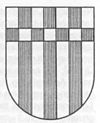22nd (Air Borne) Infantry Division (Wehrmacht)
| German 22nd Infantry Division 22. Infanterie-Division |
|
|---|---|
 |
|
| Active | 15 October 1935 - 8 May 1945 |
| Country |
|
| Branch | Army |
| Type | Infantry |
| Role | Airborne forces |
| Size | Division |
| Garrison/HQ | Bremen |
| Commanders | |
| Notable commanders |
Heinrich Kreipe |
The 22nd Infantry Division was a specialized German infantry division in World War II.
Created as 22. Infanterie-Division in 1935, one regiment participated in the 1939 Invasion of Poland; the rest of the division stayed in garrison on the Siegfried Line in case of a French attack in defense of Poland. The division retrained as 22. Luftlande-Division (Air Landing Division) for rapid tactical deployment to captured enemy airbases and performed in that role during the invasion of the Netherlands suffering heavy losses, and afterward advanced into France operating as ordinary ground infantry. Though planned for use in its air-landing role for the Battle of Crete, it was replaced by another division at the last minute. It joined Army Group South in Operation Barbarossa (1941), attacking from Romania and, operating exclusively as ordinary ground infantry, helped storm Sevastopol in the Crimea (1942).
The unit was thereafter transferred to Crete for garrison duty and mop-up operations in the Aegean, playing a major role in the Battle of Leros. During September 1943, forces of the unit committed numerous atrocities in Viannos. On 26 April 1944 the divisional commander, Generalmajor Heinrich Kreipe, was abducted by a British Special Operations Executive team led by Major Patrick Leigh Fermor and Capt Bill Stanley Moss. Kreipe's car was ambushed at night on the way from the divisional headquarters at Ano Archanes to the Villa Ariadne at Knossos and he was taken cross-country over the mountains to the south coast where he and his captors were picked up by a British vessel near Rodakino on 14 May. This operation was later portrayed in the book Ill Met by Moonlight (1950) written by Moss based on his wartime diaries, later adapted as a film of the same name. In late summer 1944, forces of the division were involved in more atrocities in Anogeia and Amari.
...
Wikipedia
